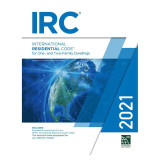2015 International Residential Code - Soft Cover
This comprehensive code combines all building, plumbing, mechanical, fuel gas, and electrical requirements for non-commercial one- and two-family dwellings into a single, easy-to-understand code. The regulations apply to single-family homes and townhouses with up to three stories. The 2015 IRC contains many important changes including:
- FEMA’s post-disaster flood investigations have resulted in provisions that require Coastal A Zones to meet the requirements for coastal high-hazard areas (Zone V). In addition, a factor of safety of one foot of additional freeboard has been added to the elevation requirements. (Section R322; RB180 and RB181 – 13)
- The wood floor, ceiling, and roof rafter span tables for Southern Pine have been revised to reflect the lower allowable spans as certified by the American Lumber Standards Committee Board of Review. Depending on the joist spacing, size, and grade, some of the allowable spans have been reduced by as much as 2 ft. - 9 in. (Chapters 5 and 8; RB250-13)
- The wood deck provisions have been significantly expanded to provide additional prescriptive design and construction details for all facets of decks, including the decking, joists, beams, posts, and connections. (Section R507; RB264-13)
- The simplified wall bracing provisions in the code have been expanded to include three-story buildings as well as buildings located in areas where the design wind speed is 130 mph and Wind Exposure Category C. (Section R602.12 and Table R602.12.4; RB324 and RB325-13)
- New provisions for photovoltaic roof shingles, including allowable roof slope, underlayment requirements and attachment have been added to the code. (Section R905.16; RB446-13)
- Provisions for rooftop-mounted photovoltaic systems have been added to the roofing chapter of the code. Included are provisions for installation, wind resistance, fire classification and the listing and labeling of the systems. (Section R907; RB447-13)
- An alternative path for residential energy compliance which provides greater flexibility and is likely to lower construction costs has been added. It is called the Energy Rating Index Compliance Alternative. (Section N1106; RE188-13)
- Chapter 23 has been comprehensively revised and re-titled to Solar Thermal Energy Systems. This includes revisions for seismic bracing, heat transfer fluids, labels and relief valves. This chapter now includes references to three solar standards for solar collectors and solar thermal systems promulgated by the Solar Rating and Certification Corporation (SRCC Standards 100, 300 and 600). (Chapter 23; RM77, 79, 82 and 84 to 93 -13)
- The weighted average of lead content used in drinking water pipe and fittings has been reduced to a “lead-free” value of not more than 0.25 percent lead. This provision meets the new requirements of the Federal Reduction of Lead in Drinking Water Act that went into effect in 2014. (Section P2905.2.1; RP102-12)









